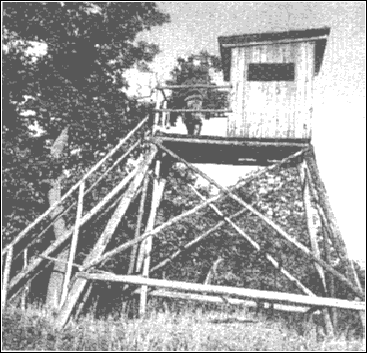
| Hunting Vacation in Germany | August 1995 | |
| Gerhard Schroeder
| ||
Imagine July, with ambients never reaching 90°F, and daylight available long enough to allow you to spot, evaluate and shoot deer until 11 pm. That's what it was like in Germany, a little south of Hamburg. Imagine also a buck season from 16 May until 15 October, with doe season starting at 15 September until 31 January. Then all you need is someone who has the hunting privileges for a small area. That person is my brother, and he was nice enough to "guide" for me.
Together with my family, I burned all my annual vacation at my folks home this year. And except for a two-day side trip to Berlin, I was back home with mom and dad all that time. Several times after (his) work, my brother Helmut would take me out hunting, from about 8 pm until absolute dark, which brought us back around 11:30 pm. He basically said that I would do the shooting, except for bandtail pigeons for which he carried a shotgun as well.
Ever wonder why there are combination guns? Well, just consider that you can simultaneously hunt deer, wild boar (which we unfortunately never did see), pigeons, and fox, and there is your starting point. It is quite a satisfying feeling to open the drilling, put a 12 gauge #5 load (from Winchester Europe, with paper hull for environmental reasons) into the left barrel, a .22 Hornet into the full-length (24") insert barrel on the right, and a 7x65R rifle round (Nosler 175 gr. Partition) in the tube nestled under and between the two 12 gauge barrels. The Hornet is adjusted within the 12 gauge tube to shoot to the same point of impact at 100 meters as the big bore. The 1.5-6x42 scope comes off quickly with a detachable mount.
And so it happened that on a single evening I first shot a pigeon off a fence post at about 80 steps with a Hornet full metal round nose, then quickly removed the scope to take a flying one with the #5 "hail", and later at last light with the 7x65R, a roe deer buck from a high stand, all with the same gun. And if you are sitting at the edge of a corn field, pass shooting pigeons, you are only one lever away from the rifle should a wild boar show up.
Neat stuff. A real hunting dog was also neat, retrieving all pigeons from well inside the corn field. The dog was also an excellent daytime playing companion for my son, Joshua, particularly since the dog, named Samson, also seemed to obey
the English commands.
A typical hunting "day" would go like this: Around 8 pm Helmut would be ready to go. We'd take our equipment, usually consisting of a drilling, 12 gauge O/U, 2 binoculars, a few shells and rubber boots into his business van and take off. 200 yards from his house begins
his hunting area. We'd drive around a little to see if we could spot game from the roads, or we would eventually park and climb into a "hochsitz," or high seat, all the while catching up on the latest gossip and hunting adventures. We'd be in the high stand, having a whispering conversation, and deer would still come into range.
At one time, we saw 5 bucks in one hour. The first four were either constantly moving (the rut was on), or too far (150 meters is pushing it on these fairly small deer).
With daylight fading around 10:30 pm, buck #5 finally came toward us. At around 120 meters he paused briefly. I had been tracking him for a while, after Helmut had given me the "go ahead." He also instructed me to not worry about the high grass in the meadow, which from our angle covered about the lower half of the deer's body. And sure enough, when I touched the set trigger on the drilling after aiming at grass, the buck disappeared into it, forever anchored when the partition found his lungs.
That was my last hunting day there, and the second buck I had bagged that evening. The first one I had seen some 3 hours earlier from the van, using a pair of Docter 8x30 binos. He was bedded in a large open field in a slight depression, way out of range. But a creek led partially in that direction. First, we entered the creek, and after some 200 meters I handed my binoculars to my brother, climbed out and robbed the remaining 80 or so steps to the top of a slight knoll, from where I could see the buck.
He was still about 120 steps away, but had already fixed his head in my direction. When I slowly got into the sitting position to get the barrel above the vegetation, the deer got up, too. But he didn't take off, and a semi-rushed shot found his lungs, too. He didn't drop though, rather walked away slowly, while I reloaded the drilling. But then he stepped backwards, like he was drunk, and Helmut, observing all this from the creek, yelled out to NOT shoot him again. Two seconds later the deer collapsed.
Some other neat experiences: A young spike was feeding in a meadow, a little out of range. Close by was a creek, lined with gorgeous tall trees. We approached on the other side of the trees, then crossed the creek. The buck was now only about 70 yards away, but had approached the creek and was mostly hidden behind low-hanging branches. Then we couldn't see him anymore.
With the wind in our faces, we decided that I would stalk closer. That wasn't too difficult, all that lush grass cushioned each step. What I didn't know, but suspected, was that the buck had bedded down. But where?
Well, I got within 10 feet of him when he bolted from his bed, where we had last seen him. He crossed the creek to safety.
Another stalk on a different buck led through a cornfield. Since it had rained earlier, I got wet from the head-high plants in a hurry. But I made steady progress anyway, which was probably wrong. When after some 100 steps, I had worked my way back to the edge of the field to look into the meadow where the buck had been, he was long gone. Drenched, I returned to the van. Only then did my brother inform me that he makes frequent stops when stalking through a cornfield. That way the noise from the stalks rubbing on your clothes isn't constant, and the deer probably tolerate it as wind gusts rustling the stalks.
My first vacation deer was bagged in a rain shower. He was busy chasing a doe. I snuck up along the meadow in a lightly wooded section, then waited, leaning against a tree. The doe did me the favor and led the pursuing buck past the tree at about 70 steps. The shot went a little too far back, but he collapsed upon entering the woods some 100 meters away.
Deer #2 was bagged from a high stand. Although a young button buck was always within range, we waited until last light when the older boy stepped out of the woods onto the field, only to meet the 175 grain partition.
These roe deer are fairly small. The four that I shot weighed between 30 - 35 pounds, field dressed. But for their size they can "eat" quite some bullet. I shoot the same 7x65R caliber (although with a 160 gr bullet) for almost all my big game hunting here in Arizona, and observed that the mulies and whitetails drop easier than those little roe deer. That is particularly the case once they are alerted and their adrenaline is flowing.
Aside from roe deer and European bandtail pigeons, which are slightly larger than the ones I've bagged on the rim, we had decided to pursue one more "exotic" species: eel. Not with the gun, not even with a fishing rod, but with shovel and bucket. Here's how:
My father has a little fish pond in a wooded section about a half mile from the house, which is fed by a small creek. That creek sometimes has native eel in it. We catch them in the summer, when water levels are low.
To show my son how we used to do it "in the old days" my father (at 83 years old, he still has the kid in him that definitely wanted to participate) and I dammed up the creek high enough to stop it from flowing for at least three hours. Then we let the water level drop downstream for about 30 minutes. We then followed the drying creek for a couple of hundred meters and concentrated on potholes. The bigger and deeper ones we would scoop dry using the bucket. The eel would usually get out of the mud during this procedure. This all is hard, unusual work, and the first couple of holes tired us out, without any success.
Then we came upon one fairly large one and decided to tackle it, but that was going to be the last one for the morning. The tedious scooping began, with all three of us taking turns. With the hole half way empty, my dad spotted a large eel, but failed to get it into the bucket. Now the excitement grew, and we scooped twice as vigorously. Then I noticed a smaller one, but could not catch it, either. Now all pain was forgotten, and we scooped the
hole totally dry. No eel! But when we poked, shoveled and kicked through the wet mud, they "surfaced," and we scooped them up with the bucket. Which was perfect timing, because when we returned to our dam, it had already begun to leak. The larger eel at about 32 inches was the biggest that we had ever taken from the little creek. A neat prize after not "fishing" the creek for over 15 years.
The two eel, which are too slimy to hold with your bare hands when they are alive, were taken home for show & tell. Then dumped out on the lawn and executed with a .177 caliber pellet to the head, gutted with the "turkey" knife I had won at last year's turkey shoot, washed, put in/on salt for the afternoon, washed again, and finally smoked for about 1.5 hours. His smoker is a small, simple sheet metal cabinet. On the bottom he put beech tree sawdust, the eels, coiled due to their length, on wire shelves above. The cabinet was then set on an open fire, which was "regulated" so that the top of the smoker could barely be touched by hand. Both eels came out extremely tender, with a rich typical eel taste. They were devoured for dinner, with enough left over for breakfast the next morning.
Needless to say, this vacation went by too quickly. Just consider the long deer season. And the disgusting temperatures in the desert.
By the way, when you travel with the family, customs isn't picky. Nobody asked for guns!
© Honeywell Sportsman Club. All rights reserved. | ||
| If you enjoyed this story, or found it useful, please consider clicking here to join the NRA at a discount of $15 off the normal membership cost. You will be supporting both this website and adding your voice in support of the Second Amendment. Thank you very much. |

|

|
|










